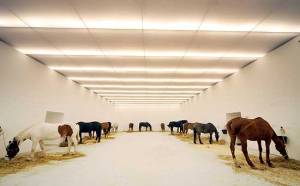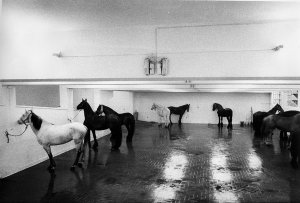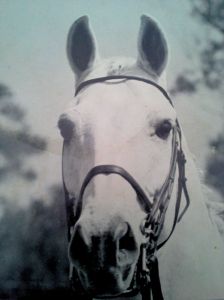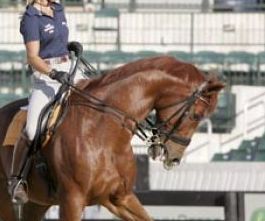I’ve been pondering the question of cruelty a lot lately. There certainly is more than enough cruelty in the world. But if you go by the internet, you would be hard pressed to find anything that we do with horses that isn’t considered cruel. Bits, shoes, blankets, stalls, clipping … even riding has been called cruel on more than one discussion I’ve observed. It’s enough to give a hardworking horsewoman a complex! But what really does rise to the level of “cruel”?

My cogitation on the topic of cruelty began with a post on a Facebook group. The post concerned a recent art exhibit in New York that recreated a much earlier famous show in Italy. The exhibit consisted of horses, tied around the gallery. That’s it – that was the whole show. Just some horses tied to the gallery walls for six hours a day, for three days (they went home to their stable at night). The Facebook post raised the question of whether this was cruelty. The group being made up of mostly animal rights activists, most immediately pushed the cruelty button. But was this really cruelty? Let’s look at the definition of cruelty:
cruelty
: a desire to cause others to suffer : the quality or state of being cruel
: actions that cause suffering
: an act or occurrence that causes suffering
Well, I think it’s pretty safe to say that the first definition didn’t apply. The people who put on the art exhibit did not seem, in interviews, to be horrible monsters set on intentionally causing suffering. The other two are a little more vague – so what qualifies as suffering?
suffering
: pain that is caused by injury, illness, loss, etc. : physical, mental, or emotional pain

Okay, I can work with that. Now, I looked at many photos of the horses in the exhibit, and read some accounts of it. Unlike the original exhibit in Italy, these horses had food and water in front of them all day. In all the photos I saw, the worst I could say was that the horses were probably bored much of the time. I saw nothing that I don’t see in pastures every day – hanging lips, dropped hips and cocked hind feet. Was it stupid? Absolutely! It was this kind of “art” that turned me off using my art degree as step toward a career path. Was it cruelty? Absolutely not!

That post raised the word cruelty in my consciousness, and I began to ponder every horse-related activity that I saw it connected to. That brings me to this picture. I’ve recently been reading through Bengt Ljungquist’s Practical Dressage Manual, and this alert fellow graces the cover of the fourth edition that I own. I like this photo – the lovely expression, the relatively simple tack (no crank nosebands then!). But the other day I was struck by how many acts of “cruelty” it represents – some of them even criminal offenses in some countries. Can you pick them out? Let me help:
- He’s wearing a bit. Not a crime anywhere that I’m aware of, but there are many on the internet who would push for it.
- He’s wearing a double-bridle. Although I have seen many uses of the double-bridle cause a great deal of pain, it is the user not the tool that is the problem. I have seen some of those same people cause as much pain using only a snaffle.
- His whiskers (vibrissae if you prefer) have been clipped off. This actually is a crime in some countries, most recently Switzerland.
- The hair inside his ears has been clipped out. This, too, is a crime in the same countries that have criminalized whisker clipping.
My guess is that his rider probably wore spurs (required in FEI level Dressage) and at some time carried a Dressage whip – those also being classified as cruel by many. On the question of tack and equipment, all that I’m going to say is that it’s not the equipment but the use of it that is cruel. My favorite quote about draw reins is relevant here (my apologies for not remembering who it came from): “Draw reins should only be used by the hands of an expert, and an expert will not need them.” The same can be said of spurs and the double-bridle, except for that pesky rule requirement for FEI Dressage. But it is not the question of equipment I want to focus on.
I do not clip my horses. It’s not out of any conscious choice about cruelty or kindness – it’s strictly laziness and the lack of need, since I’m not yet showing anyone. However, for decades my horses looked as clean shaven as the fine fellow in this photo. Was that cruel? Obviously some national governments have decided it is. But, did it create any suffering? I will take the risk of saying a categorical “No!” Once they were used to the sound of the clippers, the only reaction my horses had to the removal of their whiskers was a couple who’d wiggle their lips on the clippers. No one ever had any facial injuries from a lack of whiskers to feel hazards. If I had them running on a range, I would not have removed the whiskers, because of too many unknown hazards on an open range.
I’m not advocating for clipping horse whiskers – if you don’t like it, don’t do it. But I quarrel with the idea that it is cruel – it causes no suffering for the horse. Is it inconsiderate? Perhaps – although not as much as it would be for a cat. For all those that cry “natural” I say this – that ship sailed eons ago! The most natural thing for our horses would be to turn them out in the wild and let them take their chances – except that we’ve removed most of the suitable land for that, and our horses are too domesticated to survive it. You have only to look at the horror of horses turned loose during the economic downturn (and still, in the UK) to see that this is not an option.
As for the ears, that is a slightly different situation. Most horses are less than thrilled with this grooming practice (Dani actually leaned in to let me do her ears … but she was weird!), so I have seen some cruelty performed in the name of clean shaven ears. I’ve done my share of clean ears, when my horses would tolerate it. In our area of the globe, we have some nasty little ear gnats – clean ears are sometimes helpful with this, if you keep them wiped with repellent. The gnats wriggle right through the hair, and it’s tough to get repellent on the hair. But, when the horse is less than thrilled with the clipping, I’ll just trim the edges to make them appear neat. Again, as long as you take care of the ears, I have seen no suffering from clean shaven ears. I certainly fail to see how it should be a crime.
I consciously chose, many years ago, to not pull manes. In this case, I believe it is a cruelty question (and this is also a crime in some countries). When I was growing up, I (like many of you) were told that the horse doesn’t feel it. That didn’t make sense to me, since I could certainly feel when my hair was pulled – but it was “the thing to do”. My first horse, Wicki, had a pony-thick mane that took forever to pull. He was not happy, and I asked my instructor – but she told me he was just bored. So, I kept going – until I pulled a bunch of white hair stained red with blood! Even at twelve, you could not convince me that there was no feeling if there was blood! Thus started a lifetime of trying to find ways to get the mane I needed without pulling. I think my horses were happiest when roached – no braids!

I applaud anyone who makes choices for their horse that are grounded in their own moral sensibilities. That is, by far, the most defensible space from which to make your decisions. However, like the word “rape”, I think we need to be more careful in throwing around the word “cruel” – it has a very specific meaning, and using it too frequently robs it of the gravity and power it should have. Instead, how about “unthinking”, “inconsiderate”, “thoughtless” or even “unkind” – all convey a powerful enough, and probably more accurate, meaning for the situations most frequently debated online.
Do we really believe that trimming a horse’s whiskers is equivalent to roping a horse’s leg and flipping them at a full run? Is a few hours tied in one spot equivalent to repeatedly inflicted pain in the name of sport? I certainly hope not! I, for one, would feel so much better if we focused our attention and laws on true cruelty – abuse, neglect, starvation, anything that causes actual pain. Healthy debate on tack use, housing and grooming practices (or stupid art exhibits) is very welcome, but should be kept in perspective.
Above all … be good to your horses!
Lia
To me the question of whether the art is cruel varies from horse to horse. Horse A might be fine but horse B might hold his pee all day because he hates the floor and the observers and horse C needs to move to stay sound. If you get all horse A types it’s fine but B and C are uncomfortable and/or in pain. I suppose cruelty isn’t just about which human is wearing the spurs, but also about which horse is being spurred. Carrying a whip near an abused horse could be cruel while smacking another horse with the same whip to stop it doing something dangerous in traffic would not be.
LikeLiked by 1 person
A most excellent point! Cruelty has to also be measured by each horse’s reaction. I had a horse who could not tolerate a metal bit, so I used soft rubber – a double-bridle would have been cruelty to her. Nash gets so worked up over going places, that I’m currently contemplating whether trying to take him trail riding and to clinics would be overwhelming for him. I never had to hit Dani when I had her – yet, Noble doesn’t feel it!
Thank you for contributing that extra insight into the issue, Sparrowgrass!
LikeLiked by 1 person